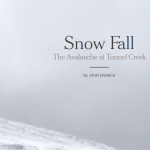“The Guardian” bietet ein WordPress-Plugin an, mit dem sich in wenigen Handgriffen viele Artikel der britischen Zeitung mit wenigen Handgriffen in Weblogs veröffentlichen lassen. “The Guardian” startet damit den ambitionierten Versuch, in der sich radikal ändernden Medienwelt neue Wege zu den Medienkonsumenten zu finden
 This article titled “Shhh! This is the New York Times” was written by Peter Preston, for The Observer on Saturday 1st October 2011 23.04 UTC
This article titled “Shhh! This is the New York Times” was written by Peter Preston, for The Observer on Saturday 1st October 2011 23.04 UTC
Moviegoing journalists obsessed about the future of their trade (if there is one) will love Page One: Inside the New York Times (possibly showing at a non-multiplex near you). Some 97 minutes of balding men standing around worrying about their jobs. But non-journalists interested by this insider’s look at America’s most revered daily may notice quite other, counter-intuitive, things.
There are very few swashbuckling operators on view, mostly people sitting at computer terminals tapping boringly away. The offices, from department to department, are closed, silent places. Nobody laughs much.
When they’re not hitting a keyboard, NYT editors, section heads, deputies, assistants and associates move seamlessly between endless meetings.What shall we put on the front page today? That’s the 10.30am conference question. When will the media correspondent deliver his touted Chicago scoop? I’ll stay at home for a week to write it, he says.
No one talks about what will sell more copies, make bigger waves, kick over hornet’s nests. Or about how stories are laid out and projected. The scoop that took a week to write debuts downpage, then wends its lugubrious way inside.
To non-American eyes, the Times seems more compiled than edited, columns assembled as though in some cathedral, voices hushed as Pulitzer prizes are announced. Even the 100 redundancies promulgated here would seem to leave 1,150 journalists gainfully employed, roughly double the number on the Guardian, Telegraph and Times. What are they all doing? Asking how long their jobs will last.

guardian.co.uk © Guardian News & Media Limited 2010
Published via the Guardian News Feed plugin for WordPress.“The Guardian” bietet ein WordPress-Plugin an, mit dem sich in wenigen Handgriffen viele Artikel der britischen Zeitung mit wenigen Handgriffen in Weblogs veröffentlichen lassen. “The Guardian” startet damit den ambitionierten Versuch, in der sich radikal ändernden Medienwelt neue Wege zu den Medienkonsumenten zu finden
 This article titled “Shhh! This is the New York Times” was written by Peter Preston, for The Observer on Saturday 1st October 2011 23.04 UTC
This article titled “Shhh! This is the New York Times” was written by Peter Preston, for The Observer on Saturday 1st October 2011 23.04 UTC
Moviegoing journalists obsessed about the future of their trade (if there is one) will love Page One: Inside the New York Times (possibly showing at a non-multiplex near you). Some 97 minutes of balding men standing around worrying about their jobs. But non-journalists interested by this insider’s look at America’s most revered daily may notice quite other, counter-intuitive, things.
There are very few swashbuckling operators on view, mostly people sitting at computer terminals tapping boringly away. The offices, from department to department, are closed, silent places. Nobody laughs much.
When they’re not hitting a keyboard, NYT editors, section heads, deputies, assistants and associates move seamlessly between endless meetings.What shall we put on the front page today? That’s the 10.30am conference question. When will the media correspondent deliver his touted Chicago scoop? I’ll stay at home for a week to write it, he says.
No one talks about what will sell more copies, make bigger waves, kick over hornet’s nests. Or about how stories are laid out and projected. The scoop that took a week to write debuts downpage, then wends its lugubrious way inside.
To non-American eyes, the Times seems more compiled than edited, columns assembled as though in some cathedral, voices hushed as Pulitzer prizes are announced. Even the 100 redundancies promulgated here would seem to leave 1,150 journalists gainfully employed, roughly double the number on the Guardian, Telegraph and Times. What are they all doing? Asking how long their jobs will last.

guardian.co.uk © Guardian News & Media Limited 2010
Published via the Guardian News Feed plugin for WordPress.“The Guardian” bietet ein WordPress-Plugin an, mit dem sich in wenigen Handgriffen viele Artikel der britischen Zeitung mit wenigen Handgriffen in Weblogs veröffentlichen lassen. “The Guardian” startet damit den ambitionierten Versuch, in der sich radikal ändernden Medienwelt neue Wege zu den Medienkonsumenten zu finden
 This article titled “Shhh! This is the New York Times” was written by Peter Preston, for The Observer on Saturday 1st October 2011 23.04 UTC
This article titled “Shhh! This is the New York Times” was written by Peter Preston, for The Observer on Saturday 1st October 2011 23.04 UTC
Moviegoing journalists obsessed about the future of their trade (if there is one) will love Page One: Inside the New York Times (possibly showing at a non-multiplex near you). Some 97 minutes of balding men standing around worrying about their jobs. But non-journalists interested by this insider’s look at America’s most revered daily may notice quite other, counter-intuitive, things.
There are very few swashbuckling operators on view, mostly people sitting at computer terminals tapping boringly away. The offices, from department to department, are closed, silent places. Nobody laughs much.
When they’re not hitting a keyboard, NYT editors, section heads, deputies, assistants and associates move seamlessly between endless meetings.What shall we put on the front page today? That’s the 10.30am conference question. When will the media correspondent deliver his touted Chicago scoop? I’ll stay at home for a week to write it, he says.
No one talks about what will sell more copies, make bigger waves, kick over hornet’s nests. Or about how stories are laid out and projected. The scoop that took a week to write debuts downpage, then wends its lugubrious way inside.
To non-American eyes, the Times seems more compiled than edited, columns assembled as though in some cathedral, voices hushed as Pulitzer prizes are announced. Even the 100 redundancies promulgated here would seem to leave 1,150 journalists gainfully employed, roughly double the number on the Guardian, Telegraph and Times. What are they all doing? Asking how long their jobs will last.

guardian.co.uk © Guardian News & Media Limited 2010
Published via the Guardian News Feed plugin for WordPress.
 “Snowfall, the Avalanche at Tunnel Creek“, das umfangreiche Multimedia-Feature der New York Times war ein großer Erfolg. Redakteur und Projektleiter John Branch erhielt dafür heuer, 2013, einen Pulitzerpreis. Das aufwändige Multimedia-Projekt war so erfolgreich, dass es in manchen Redaktionen heißt: “Wir snowfallen eine Geschichte”, wenn sie multimedia aufbereitet wird.
“Snowfall, the Avalanche at Tunnel Creek“, das umfangreiche Multimedia-Feature der New York Times war ein großer Erfolg. Redakteur und Projektleiter John Branch erhielt dafür heuer, 2013, einen Pulitzerpreis. Das aufwändige Multimedia-Projekt war so erfolgreich, dass es in manchen Redaktionen heißt: “Wir snowfallen eine Geschichte”, wenn sie multimedia aufbereitet wird.
